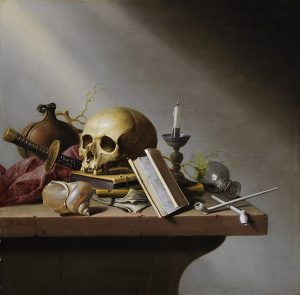 In premodern times, death was a more visible phenomenon than now, due to high mortality rates, but also to the fact that dying and death and the subsequent phases of deposition, bereavement and remembrance – more so than today – were collectively experienced, publicly performed, and commemorated in enduring monuments. Remembrance was held to extend into perpetuity, on personal grounds of love and affection, and for political and religious reasons, the latter normatively being related to the Christian doctrine of salvation, which, in Catholic contexts, called for unceasing prayer and other observances, like masses for the souls of the deceased. By continuing their existence in the afterlife, the dead remained present among the living.
In premodern times, death was a more visible phenomenon than now, due to high mortality rates, but also to the fact that dying and death and the subsequent phases of deposition, bereavement and remembrance – more so than today – were collectively experienced, publicly performed, and commemorated in enduring monuments. Remembrance was held to extend into perpetuity, on personal grounds of love and affection, and for political and religious reasons, the latter normatively being related to the Christian doctrine of salvation, which, in Catholic contexts, called for unceasing prayer and other observances, like masses for the souls of the deceased. By continuing their existence in the afterlife, the dead remained present among the living.
Among the cultural responses and expressions related to dying and death, art and architecture had a prominent position. Art and cultural historians have made significant contributions to the study of the interrelatedness of art, dying and death. These range from focused studies of individual monuments or commemorative practices to more sweeping investigations of death as motivation for art. In Painting in Florence and Siena after the Black Death (1951), for example, Millard Meiss famously argued that the experiences of plague and large-scale death effected fundamental changes in the nature of the visual arts of central Italy. Many scholars have refuted parts of Meiss’s argument, but his book has gained renewed interest in our own time of plague as a cornerstone for exploring the relationship between art and death.
Volume 72 of the Netherlands Yearbook for History of Art is dedicated to the relationship of art and death in the Low Countries and its diaspora, from premodern times to the present. The editors welcome contributions on works of art and architecture (paintings, prints, sculptures, objects of applied arts, monuments, buildings) which in one or the other way can be related to the phenomena and cultural experiences of death, dying and deposition, as well as inquiries into how death and its public rituals shaped the visual arts. Contributions may deal with both human death and death and decay in plant and animal life.
It is essential for proposals to ask how these works not only expressed particular concepts and emotions (grief, fear, horror, hope, acquiescence, desire, etc.) related to (impending) death and afterlife, but also how they shaped and imprinted such ideas and aroused and channeled such emotions on the part of the living who engaged with them. Such engagement may include any physical or mental action or performance (moving, handling, touching, viewing, praying, singing, contemplating, etc.). These characteristically, though not exclusively, occurred within the context of a particular ritual or routine – personal or communal; private or public; secular or religious – related to the following: the preparation for death; deathbed observances, both pre- and post-mortem (e.g., the administration of the last sacraments, deathwatches); the post-mortem handling of the body (e.g., embalming, autopsy, dissection, anatomical lessons); funeral and burial preparations and their actual progress; commemorative activities (e.g., prayer, votive masses, services, gatherings); and consolation (e.g., pastoral visiting and counseling).
Any analysis of such engagement should take into account the social, demographic, ideological (including religious) as well as temporal and spatial circumstances and conventions under which it occurred. One may think here of: death in the public domain versus private dying and death; differences depending on political and social standing and meaning of the deceased (e.g., rulers, statesmen, national heroes); the theme of memoria and damnatio memoriae. Given the NKJ’s focus on Netherlandish art, we encourage prospective contributors to take into account circumstances specific to the Low Countries. In this respect, the topic of iconoclasm as the ‘death’ of the veristic object or veristic representation may be dealt with as well.
The works of art and architecture to be studied along the aforementioned lines of inquiry may include, but are not limited to:
− memento mori and vanitas representations
− illustrated consolation literature, funerary poetry; offices of the dead (as illustrated in books of hours and prayer books); artes moriendi
− deathbed portraits; death masks; memory portraits (miniatures, lockets, rings, silhouettes, cameos); bereavement mementos
− representations of funeral processions, burials and entombments
− funerary decorations; burial customs and burial equipment; burial textiles; biers; grave gifts, coffins
− mausoleums; funerary chapels, churches; mausoleums, churchyards and cemeteries
− funeral monuments and tombs; tomb effigies; gravestones; wall memorials
− public memorials for the dead
− scenes of martyrdom; executions; killings; fatal accidents
− last judgements and representations of heaven and hell
− representations of anatomical lessons, autopsies and dissections
− still lives/natures mortes
The NKJ is dedicated to a particular theme each year and promotes innovative scholarship and articles that employ a diversity of approaches to the study of Netherlandish art in its wider context. For more information, see: https://brill.com/view/serial/NKJ.
Contributions to the NKJ (in Dutch, English, German or French) are limited to a maximum of 7,500 words, excluding notes and bibliography.
Following a peer review process and receipt of the complete text, the editorial board will make final decisions on the acceptance of papers.
Please send a 500-word proposal and short CV by April 15, 2021, to the volume editors:
Bart Ramakers (b.a.m.ramakers@rug.nl)
Frits Scholten (f.scholten@rijksmuseum.nl)
Edward H. Wouk (edward.wouk@manchester.ac.uk)

Leave a Reply
You must be logged in to post a comment.